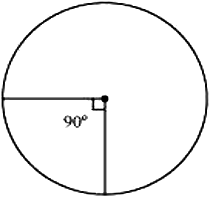NCERT Solutions Class 10 Maths Chapter 12 Areas Related to Circles
1. The radii of two circles are 19 cm and 9 cm respectively. Find the radius of the circle which has circumference equal to the sum of the circumferences of the two circles.
Answer:
Radius (r1) of 1st circle = 19 cm
Radius (r2) or 2nd circle = 9 cm
Let the radius of 3rd circle be r.
Circumference of 1st circle = 2πr1 = 2π (19) = 38π
Circumference of 2nd circle = 2πr2 = 2π (9) = 18π
Circumference of 3rd circle = 2πr
Given that,
Circumference of 3rd circle = Circumference of 1st circle + Circumference of 2nd circle
2πr = 38π + 18π = 56π
\(r = \frac{56\pi}{2\pi}= 28\)
Therefore, the radius of the circle which has circumference equal to the sum of the circumference of the given two circles is 28 cm.
2. The radii of two circles are 8 cm and 6 cm respectively. Find the radius of the circle having area equal to the sum of the areas of the two circles.
Answer:
Radius (r1) of 1st circle = 8 cm
Radius (r2) of 2nd circle = 6 cm
Let the radius of 3rd circle be r.
Area of 1st circle = \(\pi{ r_1}^2 = \pi(8)^2= 64x\)
Area of 2nd circle = \(\pi{ r_2}^2 = \pi(6)^2= 36x\)
Given that,
Area of 3rd circle = Area of 1st circle + Area of 2nd circle

However, the radius cannot be negative. Therefore, the radius of the circle having area equal to the sum of the areas of the two circles is 10 cm.
3. Given figure depicts an archery target marked with its five scoring areas from the centre outwards as Gold, Red, Blue, Black and White. The diameter of the region representing Gold score is 21 cm and each of the other bands is 10.5 cm wide. Find the area of each of the five scoring regions[Use \(\pi\) = 22/7].

Answer:
The radius of 1st circle, r1 = 21/2 cm (as diameter D is given as 21 cm)
So, area of gold region = π r12 = π(10.5)2 = 346.5 cm2
Now, it is given that each of the other bands is 10.5 cm wide,
So, the radius of 2nd circle, r2 = 10.5cm + 10.5cm = 21 cm
Thus,
∴ Area of red region = Area of 2nd circle − Area of gold region = (πr22−346.5) cm2
= (π(21)2 − 346.5) cm2
= 1386 − 346.5
= 1039.5 cm2
Similarly,
The radius of 3rd circle, r3 = 21 cm+10.5 cm = 31.5 cm
The radius of 4th circle, r4 = 31.5 cm+10.5 cm = 42 cm
The Radius of 5th circle, r5 = 42 cm+10.5 cm = 52.5 cm
For the area of nth region,
A = Area of circle n – Area of circle (n-1)
∴ Area of blue region (n=3) = Area of third circle – Area of second circle
= π(31.5)2 – 1386 cm2
= 3118.5 – 1386 cm2
= 1732.5 cm2
∴ Area of black region (n=4) = Area of fourth circle – Area of third circle
= π(42)2 – 1386 cm2
= 5544 – 3118.5 cm2
= 2425.5 cm2
∴ Area of white region (n=5) = Area of fifth circle – Area of fourth circle
= π(52.5)2 – 5544 cm2
= 8662.5 – 5544 cm2
= 3118.5 cm2
4. The wheels of a car are of diameter 80 cm each. How many complete revolutions does each wheel make in 10 minutes when the car is travelling at a speed of 66 km per hour?
Answer:
The radius of car’s wheel = 80/2 = 40 cm (as D = 80 cm)
So, the circumference of wheels = 2πr = 80 π cm
Now, in one revolution, the distance covered = circumference of the wheel = 80 π cm
It is given that the distance covered by the car in 1 hr = 66km
Converting km into cm we get,
Distance covered by the car in 1hr = (66×105) cm
In 10 minutes, the distance covered will be = (66×105×10)/60 = 1100000 cm/s
∴ Distance covered by car = 11×105 cm
Now, the no. of revolutions of the wheels = (Distance covered by the car/Circumference of the wheels)
=( 11×105)/80 π = 4375.
5.Tick the correct Solution: in the following and justify your choice : If the perimeter and the area of a circle are numerically equal, then the radius of the circle is
(A) 2 units
(B) π units
(C) 4 units
(D) 7 units
Answer:
Since the perimeter of the circle = area of the circle,
2πr = πr2
Or, r = 2
So, option (A) is correct i.e. the radius of the circle is 2 units.
6. Find the area of a sector of a circle with radius 6 cm if angle of the sector is 60° [Use \(\pi\) = 22/7].
Answer:

Let OACB be a sector of the circle making 60° angle at centre O of the circle.
Area of sector of angle θ = \(\frac{θ}{360^\circ}\times\pi r^2\)
Area of sector OACB = \(\frac{60^\circ}{360^\circ}\times\frac{22}{7}\times(6)^2\)
\(= \frac{1}{6}\times\frac{22}{7}\times6\times6=\frac{132}{7}cm^2\)
Therefore, the area of the sector of the circle making 60° at the centre of the circle is 132/7 cm2.
7. Find the area of a quadrant of a circle whose circumference is 22 cm [ Use \(\pi\) = 22/7].
Answer:

Let the radius of the circle be r.
Circumference = 22 cm
2\(\pi\) = 22
\(r = \frac{22}{2\pi}= \frac{11}{\pi}\)
Quadrant of circle will subtend 90° angle at the centre of the circle.
Area of such quadrant of the circle
